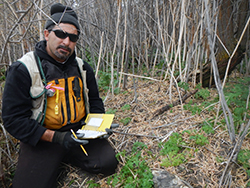
Morgan Knechtle is an environmental scientist with CDFW’s Northern Region in Yreka. He works on the Klamath River Project, which has a primary focus of estimating the return of adult salmon and steelhead to the Klamath and Trinity rivers. He is responsible for multiple field projects that manage salmonids in the Klamath River Basin, such as operating adult salmonid counting stations and coordinating adult spawning ground surveys on the Shasta River, Scott River and Bogus Creek, three highly productive salmonid tributaries to the Klamath River in Siskiyou County. Knechtle also assists with adult recovery efforts, which involve collecting biological information from returning adult salmon at Iron Gate Hatchery, and serves as one of CDFW’s technical representatives for the Klamath Dam Decommissioning Project, which involves the proposed elimination of four hydroelectric dams in northern California and Southern Oregon.
Knechtle earned a Bachelor of Science degree in freshwater fisheries from Humboldt State University and got his first job with CDFW as a scientific aide in the Russian River watershed. He was hired permanently in 2000 and spent four years working on salmonid life cycle monitoring stations on the Mendocino coast. Since 2004, he has worked with salmonids in the Klamath Basin, both on the Trinity River and in the tributaries to the Klamath River in Siskiyou County.
Who or what inspired you to become a scientist?
My love for rivers inspired me to become a scientist. During college at Humboldt State University, I was spending all of my free time fishing for salmon and steelhead and came to the realization that I could study these animals and make a living working with them.
The ability to be an advocate for fishery resources brought me to CDFW. CDFW is one of the only places a scientist can work with fisheries and truly be an objective voice for the resource. Many other organizations do not have this luxury.
What is a typical day like for you at work?
It depends on the time of year. During the fall and winter when adult salmonids are returning to the Klamath River, my world is extremely busy running and participating in multiple field projects monitoring the return of these amazing species. During the spring and summer, I spend much more time in the office crunching numbers and writing reports.
My Chinook salmon work focuses on providing information that can help accurately forecast abundance. This enables us to provide fishing opportunities while maintaining enough fish in the river for future generations. My coho salmon monitoring work focuses on providing accurate abundance information to track the status and trends of this endangered species over time.
As a technical expert on the Klamath Dam Decommissioning Project, in cooperation with other technical experts from other state and federal agencies, I help minimize effects to aquatic species inhabiting the Klamath River during the decommissioning phase of the project. Additionally, I participate in post-dam removal planning projects, including creating plans on how to implement the Iron Gate Hatchery post dam removal and coordinate with Oregon scientists on the reintroduction of salmon above Iron Gate Dam, with a goal of ensuring the recovery of salmonids and aquatic species above the project area.
What is the most rewarding project that you have worked on for CDFW?
Although the project is not yet complete, the Klamath Dam Decommissioning Project has the potential to be the most rewarding project I have worked on. It stands to be the largest river restoration project to ever be completed in North America, and given that status, as one can imagine, the project has a lot of moving parts. The potential benefits to salmonids in the Klamath and the improvements to the health of the river itself could be enormous. The long-term predicted improvements to water quality, habitat availability, natural flow dynamics and restoration of natural processes to the Klamath River will improve conditions, for not only anadromous salmon and steelhead but also the rest of the plant and animal community that depend on the river for part or all of their life history.
What is the most challenging aspect of your career as an environmental scientist?
It is extremely challenging when social and political concerns get mixed in with natural resource management. Working with coho salmon in the Klamath Basin has been very challenging due to its listed status and the fact that their abundance is extremely low.
If you had free reign and unlimited funding, what scientific project would you most like to do?
With unlimited funding, I would like to track and monitor the recovery of spring Chinook in the upper Klamath River post dam removal. They are nearly extinct and they are thought to once have been the most abundant species in the Klamath River Basin.
What aspect of working on the Klamath River is particularly challenging or rewarding?
Multiple stakeholders -- which include Native American tribes, federal and state trustee agencies, and freshwater and ocean anglers -- in the Klamath Basin make some aspects of salmon management challenging. However, when progress is made to restore the river, it is also extremely rewarding because you know that groups with very different perspectives have come together, negotiated agreement and reached consensus on difficult issues.
What is your favorite species to interact with or study?
Steelhead trout are my favorite species to work with. Steelhead are the most elusive of the Klamath salmonids and their complex life history make them a very difficult species to study. They are also my favorite fish to catch.
Any advice for people considering careers in science or natural resources?
The most obvious is for folks to stay in school and graduate from college. In addition, volunteering and interning in their field of interest early in their education is a benefit to get a taste of what the career might really be like.
CDFW photos of Morgan Knechtle working along the Shasta River.